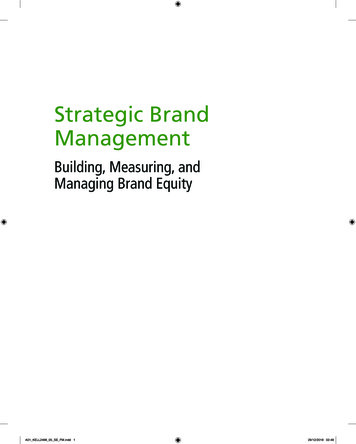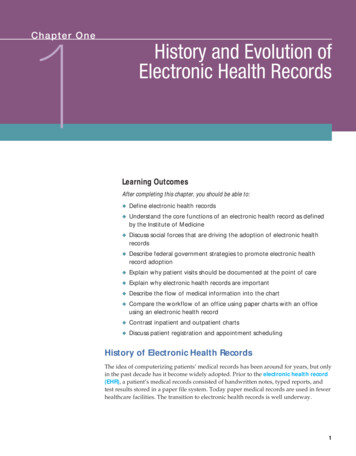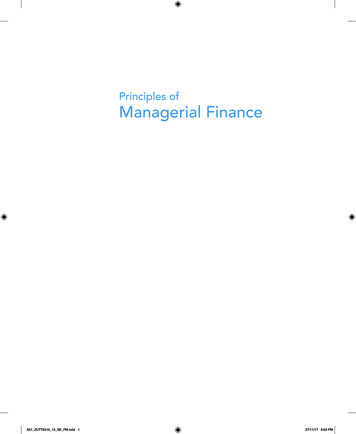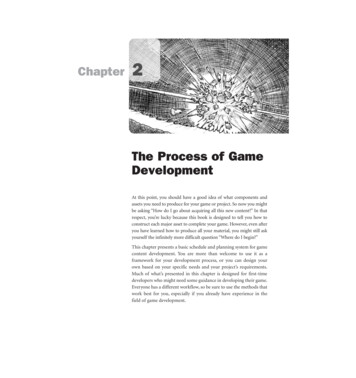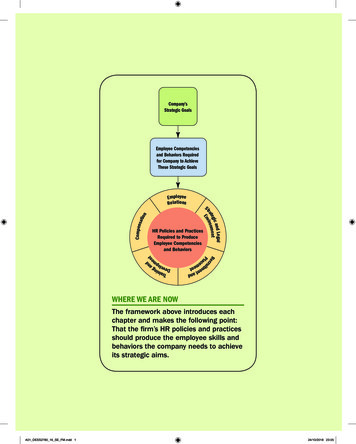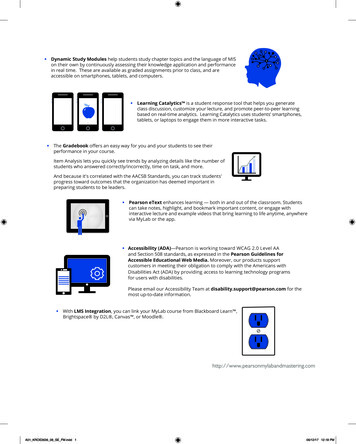
Transcription
Dynamic Study Modules help students study chapter topics and the language of MISon their own by continuously assessing their knowledge application and performancein real time. These are available as graded assignments prior to class, and areaccessible on smartphones, tablets, and computers. Learning Catalytics is a student response tool that helps you generateclass discussion, customize your lecture, and promote peer-to-peer learningbased on real-time analytics. Learning Catalytics uses students’ smartphones,tablets, or laptops to engage them in more interactive tasks.The Gradebook offers an easy way for you and your students to see theirperformance in your course.Item Analysis lets you quickly see trends by analyzing details like the number ofstudents who answered correctly/incorrectly, time on task, and more.And because it's correlated with the AACSB Standards, you can track students'progress toward outcomes that the organization has deemed important inpreparing students to be leaders. Pearson eText enhances learning — both in and out of the classroom. Studentscan take notes, highlight, and bookmark important content, or engage withinteractive lecture and example videos that bring learning to life anytime, anywherevia MyLab or the app. Accessibility (ADA)—Pearson is working toward WCAG 2.0 Level AAand Section 508 standards, as expressed in the Pearson Guidelines forAccessible Educational Web Media. Moreover, our products supportcustomers in meeting their obligation to comply with the Americans withDisabilities Act (ADA) by providing access to learning technology programsfor users with disabilities.Please email our Accessibility Team at disability.support@pearson.com for themost up-to-date information. With LMS Integration, you can link your MyLab course from Blackboard Learn ,Brightspace by D2L , Canvas , or Moodle .http://www.pearsonmylabandmastering.comA01 KROE3636 08 SE FM.indd 106/12/17 12:18 PM
Dear Student,Honestly, this is a fun class. It’s fun to take because you’ll learn about things that dominate newsheadlines every day. You’ll learn about things like self-driving cars, 3D printing, social media, BigData, virtual reality, the cloud, and cyber security. No, it’s not a programming class. It’s not intendedto be a class where you learn a bunch of boring technical terms and computer code. Not at all.This class is about using technology to create value. For example, the smartphone sitting next toyou is a piece of technology that is probably very valuable to you. It’s an amazing piece of hardwarethat contains software, databases, and artificial intelligent agents. You use it to browse the Web,collaborate with friends, take pictures, post to social media, and make online purchases. More than85 percent of college students have a smartphone, and 46 percent say they can’t live without it.That’s value, and they’re willing to pay for it.And that’s what information systems are all about. Innovators like Steve Jobs, Bill Gates, Larry Ellison,Mark Zuckerberg, Larry Page, Sergey Brin, and Jeff Bezos have used technology to create value fortheir customers. As a result, they have made billions of dollars, revolutionized commerce, and createdsome of the largest companies in the world. And you can do the same thing in your personal life.You can use technology to get a great job, increase your earning potential, and become indispensableto your future employer. You may not be a superstar entrepreneur like Steve Jobs, but you can exceedbeyond your expectations by applying the knowledge you learn in this class. Companies are becomingincreasingly dependent on technology. They need people who understand how to use new technologyto solve new types of problems. And that’s you.Think about it. Over time, technology creates new jobs that didn’t exist before. Mobile applicationdevelopers, social media analysts, information security specialists, business intelligence analysts,and data architects didn’t exist 20—even 10—years ago. Similarly, the best jobs 20 years from nowprobably don’t currently exist.The trick to turning information systems to your advantage is being able to predict technologicalinnovations and then get ahead of them. During your career, you will find many opportunities for theinnovative application of information systems in business and government—but only if you knowhow to look for them.Once found, those opportunities become your opportunities when you—as a skilled, creative, non-routineproblem solver—apply emerging technology to facilitate your organization’s strategy. This is true whetheryour job is in marketing, operations, sales, accounting, finance, entrepreneurship, or another discipline.Congratulations on deciding to study business. Use this course to help you obtain and then thrive inan interesting and rewarding career. Learn more than just the MIS terminology—understand theways information systems are transforming business and the many, many ways you can participate inthat transformation.In this endeavor, we wish you, a future business professional, the very best success!David Kroenke & Randy BoyleA01 KROE3636 08 SE FM.indd 206/12/17 12:18 PM
The GuidesEach chapter includes two unique guides that focus on current issues in information systems. Ineach chapter, one of the guides focuses on an ethical issue in business. The other guide focuseson careers in the field of information systems. The content of each guide is designed to stimulatethought, discussion, and active participation in order to help you develop your problem-solvingskills and become a better business professional.Chapter 1Chapter 5Ethics: Ethics and ProfessionalResponsibility, p. 20Ethics: Querying Inequality?, p. 142Career Guide: Senior TechnicalAnalyst, p. 272Career Guide: Senior DatabaseEngineer, p. 144Chapter 10Career Guide: Five-Component Careers,p. 22Chapter 6Ethics: Exhaustive Cheating, p. 308Chapter 2Ethics: Cloudy Profit?, p. 176Career Guide: Security Consultant,p. 310Ethics: Big Brother Wearables, p. 46Career Guide: Senior Network Manager,p. 178Chapter 11Career Guide: Software ProductManager, p. 48Chapter 7Ethics: Training Your Replacement,p. 336Chapter 3Ethics: Paid Deletion, p. 204Career Guide: Senior Data Analyst, p. 338Ethics: The Lure of Love Bots p. 74Career Guide: IT Technical Manager, p. 206Career Guide: Director of Architecture,p. 76Chapter 8Ethics: Estimation Ethics, p. 364Ethics: Synthetic Friends, p. 238Career Guide: Developing Your PersonalBrand, p. 366Chapter 4Ethics: Free Apps for Data, p. 111Career Guide: Freelance Digital Marketer& Content Creator, p. 240Career Guide: Supportability ProgramManager, p. 114Chapter 9Ethics: MIS-Diagnosis, p. 270A01 KROE3636 08 SE FM.indd 3Chapter 12Chapter Extension 16Career Guide: Director, Asian Operations,p. 60606/12/17 6:00 PM
LEARNING AIDS FOR STUDENTSWe have structured this book so you can maximize the benefit from the time you spend reading it.As shown in the table below, each chapter includes a series of learning aids to help you succeed inthis riven ChapterLearning ObjectivesThese queries, and thesubsequent chapter sectionswritten around them, focus yourattention and make your readingmore efficient.Identify the main point ofthe section. When you cananswer each question,you’ve learned the mainpoint of the section.Chapter 6, Q6-1: Why Is theCloud the Future for MostOrganizations?GuidesEach chapter includes twoguides that focus on currentissues relating to informationsystems. One addressesethics, and the other addressesinformation systems careers.Stimulate thought anddiscussion. Learn aboutreal-world IS jobs. Help youlearn to respond to ethicaldilemmas in business.Chapter 5 Ethics Guide:Querying Inequality?Each chapter of this textincludes a feature called SoWhat? This feature presentsa current issue in IS that isrelevant to the chapter contentand asks you to consider whythat issue matters to you as afuture business professional.Understand how thematerial in the chapterapplies to everydaysituations.Chapter 2 So What?:Augmented CollaborationSo What?How Does the Knowledge in This section revisits the opening Summarizes theThis Chapter Help You? (near scenario and discusses what the “takeaway” points fromthe end of each chapter)chapter taught you about it.the chapter as they applyto the company or personin the story and to you.Chapter 9 Career Guide:Manager, Data and AnalyticsChapter 11 How Does theKnowledge in This ChapterHelp You?Active ReviewEach chapter concludes with asummary-and-review section,organized around the chapter’sstudy questions.Offers a review ofimportant points in thechapter. If you can answerthe questions posed, youunderstand the material.Chapter 9 Active ReviewKey Terms and ConceptsHighlight the major terms andconcepts with their appropriatepage references.Provide a summary of keyterms for review beforeexams.Chapter 6 Key Terms andConceptsivA01 KROE3636 08 SE FM.indd 406/12/17 12:18 PM
ResourceDescriptionBenefitExampleUsing Your KnowledgeThese exercises ask you totake your new knowledge onestep further by applying it to apractice problem.Tests your critical-thinkingskills and keeps remindingyou that you are learningmaterial that applies to thereal world.Chapter 4 Using YourKnowledgeCollaboration ExerciseA team exercise that focuses onthe chapter’s topic.Use Google Drive,Windows OneDrive,Microsoft SharePoint,or some other tool tocollaborate on teamanswers.Collaboration Exercise 3, whichexplores the use of informationsystems at a high-value bikerental serviceCase StudyA case study closeseach chapter. You willreflect on real organizations’use of the technology orsystems presented in thechapter and recommendsolutions to businessproblems.Requires you to applynewly acquired knowledgeto real situations.Case Study 6: FinQloudForever . . . Well, at Least forthe Required Interval . . .Application Exercises (at theend of the book)These exercises ask you tosolve business situations usingspreadsheet (Excel)or database (Access)applications and other Officeapplications.Help develop yourcomputer skills.6-2, which builds on yourknowledge from Chapter6 by asking you to importspreadsheet data into Accessand produce cost reportsSharePoint HostingPearson will hostMicrosoft SharePoint sitecollections for your university.Students need access toMyMISLab and a browser toparticipate.Enables students tocollaborate using theworld’s most popularcollaboration software.A01 KROE3636 08 SE FM.indd 506/12/17 12:18 PM
A01 KROE3636 08 SE FM.indd 606/12/17 12:18 PM
ExperiencingMISEighth EditionDavid M. KroenkeRandall J. BoyleA01 KROE3636 08 SE FM.indd 706/12/17 12:18 PM
Vice President, IT & Careers: Andrew GilfillanSenior Portfolio Manager: Samantha LewisManaging Producer: Laura BurgessAssociate Content Producer: Stephany HarringtonPortfolio Management Assistant: Madeline HouptDirector of Product Marketing: Brad ParkinsProduct Marketing Manager: Heather TaylorProduct Marketing Assistant: Jesika BetheaField Marketing Manager: Molly SchmidtField Marketing Assistant: Kelli FisherCover Image: Hiroshi Watanab/Getty ImagesVice President, Product Model Management: Jason FournierSenior Product Model Manager: Eric HakansonLead, Production and Digital Studio: Heather DarbyDigital Studio Course Producer: Jaimie NoyProgram Monitor: SPi GlobalFull-Service Project Management and Composition:Cenveo Publisher ServicesPrinter/Binder: LSC CommunicationsCover Printer: PhoenixText Font: 9.5/13 Photina MT ProMicrosoft and/or its respective suppliers make no representations about the suitability of the information contained in the documents and relatedgraphics published as part of the services for any purpose. All such documents and related graphics are provided “as is” without warranty of anykind. Microsoft and/or its respective suppliers hereby disclaim all warranties and conditions with regard to this information, including all warrantiesand conditions of merchantability, whether express, implied or statutory, fitness for a particular purpose, title and non-infringement. In no eventshall Microsoft and/or its respective suppliers be liable for any special, indirect or consequential damages or any damages whatsoever resulting fromloss of use, data or profits, whether in an action of contract, negligence or other tortious action, arising out of or in connection with the use orperformance of information available from the services.The documents and related graphics contained herein could include technical inaccuracies or typographical errors. Changes are periodicallyadded to the information herein. Microsoft and/or its respective suppliers may make improvements and/or changes in the product(s) and/or theprogram(s) described herein at any time. Partial screen shots may be viewed in full within the software version specified.Microsoft and Windows are registered trademarks of the Microsoft Corporation in the U.S.A. and other countries. This book is not sponsored orendorsed by or affiliated with the Microsoft Corporation.Copyright 2019, 2017, 2016 by Pearson Education, Inc. or its affiliates. All Rights Reserved. Manufactured in the United States ofAmerica. This publication is protected by copyright, and permission should be obtained from the publisher prior to any prohibited reproduction,storage in a retrieval system, or transmission in any form or by any means, electronic, mechanical, photocopying, recording, or otherwise. Forinformation regarding permissions, request forms, and the appropriate contacts within the Pearson Education Global Rights and Permissionsdepartment, please visit www.pearsoned.com/permissions/.Acknowledgments of third-party content appear on the appropriate page within the text.PEARSON, ALWAYS LEARNING, and MYLab MIS are exclusive trademarks owned by Pearson Education, Inc. or its affiliates in the U.S. and/orother countries.Unless otherwise indicated herein, any third-party trademarks that may appear in this work are the property of their respective owners, and anyreferences to third-party trademarks, logos, or other trade dress are for demonstrative or descriptive purposes only. Such references are not intendedto imply any sponsorship, endorsement, authorization, or promotion of Pearson’s products by the owners of such marks, or any relationshipbetween the owner and Pearson Education, Inc. or its affiliates, authors, licensees, or distributors.Library of Congress Cataloging-in-Publication Data cip to come 10 9 8 7 6 5 4 3 2 1ISBN 10: 0-13-477363-2ISBN 13: 978-0-13-477363-6A01 KROE3636 08 SE FM.indd 806/12/17 12:18 PM
To C. J., Carter, and Charlotte—David KroenkeTo Courtney, Noah, Fiona, Layla, and Henry—Randy BoyleA01 KROE3636 08 SE FM.indd 906/12/17 12:18 PM
CONTENTS OVERVIEWExperiencing MIS offers basic topic coverage of MIS in its 12 chapters and more in-depth,expanded coverage in its chapter extensions. This modular organization allows you to pick andchoose among those topics. Here chapter extensions are shown below the chapters to which theyare related. You will preserve continuity if you use each of the 12 chapters in sequence. In mostcases, a chapter extension can be covered any time in the course after its related chapter. You neednot use any of the chapter extensions if time is short.Part 1 Why MIS?Chapter 1 The Importance of MIS 3Chapter 2 Business Processes, Information Systems, andInformation 31CE 1 Collaboration Information Systems for Decision Making,CE 2 Collaborative Information Systems for StudentProblem Solving, and Project Management 373Projects 386Part 2 Information TechnologyChapter 4 Hardware and Software 87Chapter 5 Database Processing 123CE 3 Mobile Systems 407CE 4 Introduction to Microsoft Excel 2016 423CE 5 Database Design 442CE 6 Using Microsoft Access 2016 457Part 3 Using IS for Competitive AdvantageChapter 7 Processes, Organizations, and Information Systems 187 Chapter 8 Social Media Information Systems 215CE 9 Enterprise Resource Planning (ERP) Systems 522CE 10 Supply Chain Management 537CE 11 Enterprise Social Networks and KnowledgeManagement 545Part 4 Information Systems ManagementChapter 10 Information Systems Security 281Chapter 11 Information Systems Management 317CE 15 Data Breaches 592CE 16 International MIS 603CE 17 Systems Development ProjectManagement 622xA01 KROE3636 08 SE FM.indd 1006/12/17 12:19 PM
Chapter 3 Organizational Strategy, Information Systems,and Competitive Advantage 59Chapter 6 The Cloud 155CE 7 Using Excel and Access Together 477CE 8 Network and Cloud Technology 505Chapter 9 Business Intelligence Systems 247CE 12 Database Marketing 558CE 13 Reporting Systems and OLAP 567CE 14 Artificial Intelligence and Automation 578Chapter 12 Information Systems Development 345CE 18 Agile Development 635CE 19 Business Process Management 645xiA01 KROE3636 08 SE FM.indd 1106/12/17 12:19 PM
CONTENTSPreface p. xxiiiPART 1 Why MIS?CHAPTER 1: THE IMPORTANCEOF MIS P. 31. Why Is Introduction to MIS the Most Important Classin the Business School? p. 5The Digital Revolution p. 5Evolving Capabilities p. 5Moore’s Law p. 6Metcalfe’s Law p. 7Other Forces Pushing Digital Change p. 7This is the Most Important Class in the School ofBusiness p. 82. How Will MIS Affect Me? p. 9How Can I Attain Job Security? p. 9How Can Intro to MIS Help You LearnNonroutine Skills? p. 103. Why Are Mis-Related Jobs in High Demand? p. 11What is the Bottom Line? p. 13So What?: A Is for Alphabet p. 144. What Is MIS? p. 15Components of an Information System p. 15Management and use of Information Systems p. 16Achieving Strategies p. 175. What Is Your Role in is Security? p. 17Strong Passwords p. 18Password Etiquette p. 18How does the knowledge in this chapter help you? p. 19Ethics Guide Ethics and ProfessionalResponsibility p. 20Career Guide Five-Component Careers p. 222. How Can Business Process Modeling HelpOrganizations? p. 33How Best Bikes Works p. 33The Existing Best Bikes Process p. 34How Best Bikes Processes Must Change to Support 3DPrinting p. 363. How Can Information Systems Improve ProcessQuality? p. 37What Is Process Quality? p. 37Using Information Systems to Improve ProcessQuality p. 394. What Is Information? p. 40Definitions Vary p. 40Where Is Information? p. 41So What?: Augmented Collaboration. p. 425. What Data Characteristics are Necessary for QualityInformation? p. 43Accurate p. 43Timely p. 43Relevant p. 44Just Barely Sufficient p. 44Worth Its Cost p. 44How does the knowledge in this chapter help you? p. 45Ethics Guide Big Brother Wearables p. 46Career Guide Software Product Manager p. 48CASE STUDY 2: Eating Our Own Dog Food p. 52CHAPTER 3: ORGANIZATIONALSTRATEGY, INFORMATIONSYSTEMS, AND COMPETITIVEADVANTAGE P. 591. How Does Organizational Strategy DetermineInformation Systems Structure? p. 612. What Five Forces Determine IndustryStructure? p. 61CASE STUDY 1: zulily p. 263. What Is Competitive Strategy? p. 63CHAPTER 2: BUSINESS PROCESSES,INFORMATION SYSTEMS, ANDINFORMATION P. 314. How Does Competitive Strategy Determine ValueChain Structure? p. 63Primary Activities in the Value Chain p. 64Support Activities in the Value Chain p. 65Value Chain Linkages p. 651. Why Does the Falcon Security Team Need toUnderstand Business Processes? p. 335. How Do Value Chains Determine Business Processesand Information Systems? p. 65xiiA01 KROE3636 08 SE FM.indd 1206/12/17 12:19 PM
6. How Do Information Systems Provide CompetitiveAdvantages? p. 67So What?: The Autonomous Race p. 68Competitive Advantage Via Products p. 69Competitive Advantage VIA Business Processes p. 69How Can an Organization Use is to Create CompetitiveAdvantages? p. 70How Does this System Create a Competitive Advantage?p. 72How does the knowledge in this chapter help you? p. 73Ethics Guide The Lure of Love Bots p. 74Career Guide Director of Architecture p. 76CASE STUDY 3: The Amazon of Innovation p. 80PART 2 InformationTechnologyCHAPTER 4: HARDWARE ANDSOFTWARE P. 871. What Do Business Professionals Need To Kno
Ethics: Big Brother Wearables, p. 46 Career Guide: Software Product Manager, p. 48 Chapter 3 Ethics: The Lure of Love Bots p. 74 Career Guide: Director of Architecture, p. 76 Chapter 4 Ethics: Free Apps for Data, p. 111 Career Guide: Supportability Program Manager, p. 114 Chapter 5 Ethi




